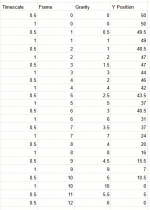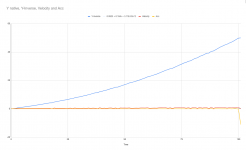SpawnStorm
New member
1. Character controller variant (Ultimate Character Controller, First Person Controller, etc.).
Third Person Controller
2. Unity version (include which SRP, beta Unity versions aren't supported)
2020.3.18f1 also tested on 2021.1.3f1
3. Bug description
Jump, and probably all AddExternalForce calls, do not appropriately scale to m_TimeScale changes.
4. Steps to reproduce
Launch Demo Scene
Move to main room, and use the default Jump ability
Note the height Nolan's head reaches at the apex of the jump. I suggest using a breakpoint to ensure only one frame of force is added.
Change UltimateCharacterLocomotion > TimeScale to 0.2f
Repeat the Jump
Observe the height is incorrect.
5. The full error message (if any)
None.
A bit of background:
I'm working on a project that has several time manipulation mechanics. If I slow a player or NPC down, I do not expect their Jump (or possible other force based abilities) to suddenly change in effective power.
I have inspected and duplicated the Jump ability, modified the ApplyJumpForce > AddForce(vector, frames, scaleByMass, scaleByTime), set scaleByTime to false.
This sort of improves the situation, but now it jump apex goes down by too much. The greater the delta from Timescale=1 the greater the effect.
Changing the update location to FixedUpdate isn't feasible, because this seems to mess with the Platform logic. Nolan's feet sink into vertical platforms.
Third Person Controller
2. Unity version (include which SRP, beta Unity versions aren't supported)
2020.3.18f1 also tested on 2021.1.3f1
3. Bug description
Jump, and probably all AddExternalForce calls, do not appropriately scale to m_TimeScale changes.
4. Steps to reproduce
Launch Demo Scene
Move to main room, and use the default Jump ability
Note the height Nolan's head reaches at the apex of the jump. I suggest using a breakpoint to ensure only one frame of force is added.
Change UltimateCharacterLocomotion > TimeScale to 0.2f
Repeat the Jump
Observe the height is incorrect.
5. The full error message (if any)
None.
A bit of background:
I'm working on a project that has several time manipulation mechanics. If I slow a player or NPC down, I do not expect their Jump (or possible other force based abilities) to suddenly change in effective power.
I have inspected and duplicated the Jump ability, modified the ApplyJumpForce > AddForce(vector, frames, scaleByMass, scaleByTime), set scaleByTime to false.
This sort of improves the situation, but now it jump apex goes down by too much. The greater the delta from Timescale=1 the greater the effect.
Changing the update location to FixedUpdate isn't feasible, because this seems to mess with the Platform logic. Nolan's feet sink into vertical platforms.



